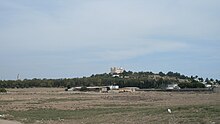The Circus of Carthage is a Roman circus in Carthage, in present-day Tunisia. Used for chariot racing, it was modeled on the Circus Maximus in Rome and other circus buildings throughout the Roman Empire. Measuring more than 470 m in length and 30 m in width,[1] it could house up to 45,000 spectators, roughly one third of the Circus Maximus.


History
editThe building seems to have been constructed sometime around 238 AD, and was used for several years before its official dedication. Salvian reports that as the Vandal armies closed in around Carthage they were met by "the sound of the people as they roared acclamations in the circus".[2]
Circus of Carthage design
editA brief description of the Circus of Carthage exists based on a mosaic found in Bardo National Museum in Tunis: "It is the only mosaic to show both the interior of the arena and the exterior façade, which has two arcades separated by a cornice. There also is an awning over the seats, which continue over the carceres, conveying more the appearance of an amphitheatre than a circus. The two temple-like structures above the seating are novel, as well, and may be situated at the break and finish lines."[3][4]
Building usage
editThe Circus of Carthage was Rome's second largest circus, one that rivaled the Circus Maximus.
The arena while smaller hosted many gamblers betting on the events there such as gladiatorial bouts and chariot races.
Building materials
editRemains from the Circus Maximus, specifically the spina (a dividing barrier) was put into the Circus of Carthage, as well as the Circus of Maxentius and the city of Vienne located in France. These remains of the spina are marble.[5]
See also
edit- Hippodrome – a Greek arena also used for chariot racing
- Carthage Punic Ports
References
edit- ^ Humphrey, J.H. (1986). Roman Circuses: Arenas for Chariot Racing. University of California Press. p. 446. ISBN 9780520049215. Retrieved 2015-08-14.
- ^ Brown, Peter (2013-09-02). Through the Eye of a Needle: Wealth, the Fall of Rome, and the Making of Christianity in the West, 350-550 AD. Princeton University Press. ISBN 978-1400844531.
- ^ "The Circus at Carthage".
- ^ Mosaïques de Tunisie (1976) by Georges Fradier and André Martin; Roman Circuses: Arenas for Chariot Racing (1986) by John H. Humphrey.
- ^ Peck, Harry Thurston (1897). "Harper's Dictionary of Classical Literature and Antiquities".